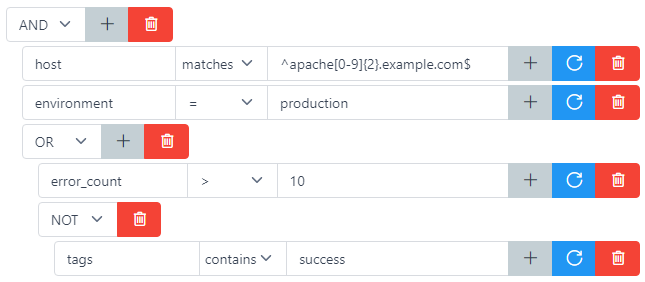Conditions#
Overview#
Conditions are used by all process plugins. It is only when a condition is true that a process plugin gets executed.
Conditions can also be used for searching in the web interface. A query language has been created to facilitate writing them.
Empty conditions are always true
A basic condition is formed with a keyword, a field and sometimes a value. It is executed against each field of an alert.
Logical operators#
Binary operators (AND, OR) can join 2 conditions while NOT operator transforms the current condition.
AND#
ConditionA AND ConditionB is true only if ConditionA is true and ConditionB is true.
OR#
ConditionA OR ConditionB is true only if ConditionA is true or ConditionB is true.
NOT#
NOT ConditionA is true only if ConditionA is false.
Keywords#
Keywords are used to compare an alert’s field with an expected value.
Hint
Nested fields can be referenced by using dot notation (.): field.nestedfield
Equals (=)#
Field = Value is true only if the alert has the field Field and its corresponding value is exactly Value.
Different (!=)#
Field != Value is true only if the alert has the field Field and its corresponding value is not exactly Value.
Greater than (>)#
Field > Value is true only if the alert has the field Field, its corresponding value can be compared with Value and is greater than it.
Greater or equal to (>=)#
Field >= Value is true only if the alert has the field Field, its corresponding value can be compared with Value and is greater or equal to it.
Lower than (<)#
Field < Value is true only if the alert has the field Field, its corresponding value can be compared with Value and is lower than it.
Lower or equal to (<=)#
Field <= Value is true only if the alert has the field Field, its corresponding value can be compared with Value and is lower or equal to it.
Matches#
Field ~ Value is true only if the alert has the field Field and its corresponding value regex matches Value (case insensitive).
Exists#
Field ? is true only if the alert has the field Field.
Contains#
Field contains Value is true only if the alert has the field Field and if either of the following is true:
The field corresponding value is a string and
Valueis a substring of it.The field corresponding value is an array and
Valueis an element of it.
Search#
search Word is true only if Word appears in any of the alert’s fields or values.
Caution
Search keyword should avoid being used too frequently as it is a lot more compute intensive than other keywords.
Web interface#

Since an empty condition is always true, the first click on [+] button will create a basic condition.
A click on a basic condition [+] button will add another condition separated by a binary operator.
A click on a binary operator [+] button will add another condition under the same operator.
A click on the blue button will clear the basic condition.
A click on a basic condition delete button will delete it. If it was the second to last remaining children of a binary operator, the operator will get deleted as well to only display its remaining child.
A click on a logical operator delete button will delete all its children.
